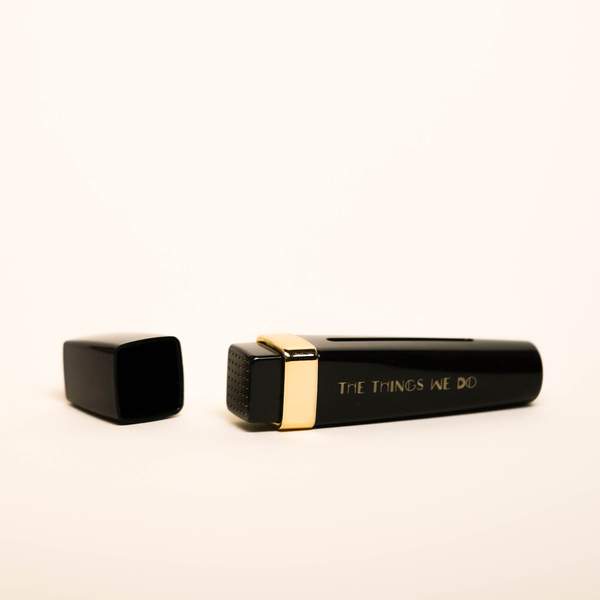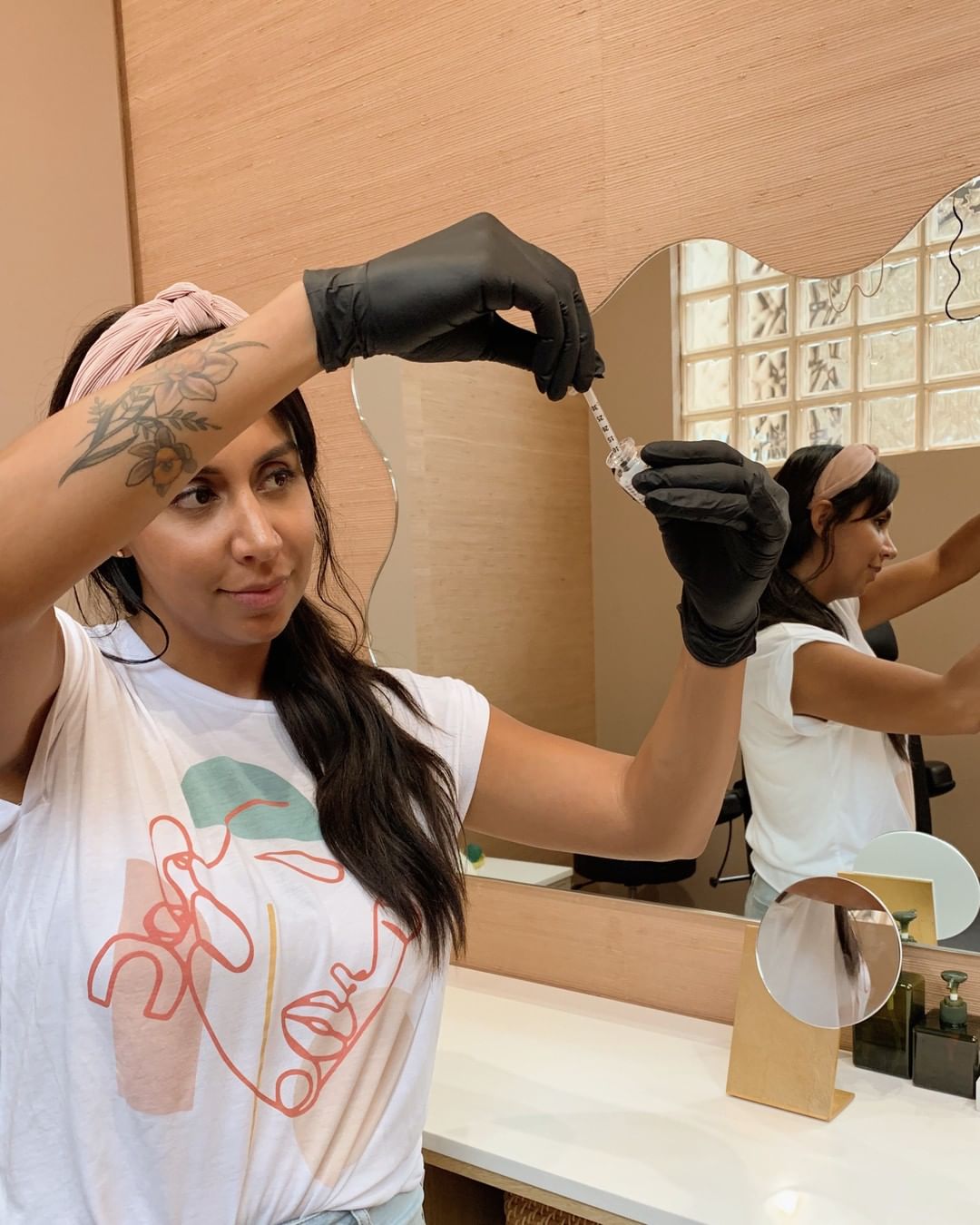How to Get Rid of Stubborn Dark Circles Like an A-List Esthetician


Dark under-eye circles are one of our most frustrating skin concerns—not only because they make us look like a long-lost member of the Cullen family, but because, try as we might, they can feel downright impossible to improve or vanish all together. The reason? Dark circles (and whatever it is that's causing them) are unique to us as individuals. While my shadowy under-eyes might be due to genetics or allergies, another person could have a lack of sleep, too many margaritas, or even something as basic as bone structure to blame. Since cause, of course, has major dictation over your treatment plan, we contacted two of Los Angeles's most-wanted skin pros—Vanessa Lee, RN, and founder of The Things We Do, and Kerry Benjamin, esthetician, and founder of StackedSkincare, for all of their expert insight on the topic.
The good news: Both Lee and Benjamin agree dark under-eye circles can definitely be improved with the right treatment plan—at home or in-office. Below, they're sharing all their best intel regarding treatments, products, and lifestyle habits, and we'll also dig a bit deeper into the various causes so. Keep scrolling!
The Most Common Causes of Dark Circles

As we mentioned above, dark circles can occur for a variety of reasons, but according to Benjamin and Lee, there's a specific list of potential causes you should definitely be aware of.
"Usually, a red or purple hue to the under eyes indicates irritated or broken blood vessels under the skin, and since the under-eye skin is thinner and more delicate, this can show up as dark circles," explains Lee. Additionally, she tells us dark circles are often genetic and are especially common in people with olive, yellow, and brown undertones. "Lastly, when someone is dehydrated, not eating well, and under stress, dark circles can appear," she adds.
Allergies and congestion: When you are stuffed up, the blood vessels around your eyes dilate, which in turn, causes the area around your eyes to darken.
Sleep deprivation: Not getting enough sleep can elevate inflammation levels within the body, which makes it harder for constricted blood vessels to drain the blood from under your eyes.
Too much sleep: Yep, it's true! As Benjamin explains, if you’re lying down for too long, blood can pool underneath the eyes and show up as dark circles.
Too much salt: Loading up on salt causes fluid retention all over the body and can increase bruise-like shadows and puffiness under the eyes.
Crying: Adding insult to injury, shedding tears increases inflammation around the eyes, which can lead to dark circles.
Age: Benjamin explains that as we age, the skin around the eyes thins, making the blood under the skin more visible.
Hyperpigmentation: If your undereye darkness is brown and doesn’t change in color, it could be hyperpigmentation linked to genetics, sun exposure, or trauma to the eye area.
Bone structure: A hollow bone structure can contribute to the appearance of dark circles, but luckily, there are plenty of things you can do to help correct the look of under-eye shadows and darkness.

Can You Actually Get Rid of Dark Circles?

"Dark circles can definitely be improved," confirmes Lee. "I see patients who are concerned about their dark circles all of the time in my office, and because there are so many different causes, our beauty plan can consist of a few different steps. Usually, we'll start with an in-office treatment to induce new collagen in the skin, thus creating a brighter matrix of tissue and reducing dark circles." Additionally, she explains that it is essential to incorporate a high-quality under-eye product into your skincare routine and to try to load up on as much beauty sleep as possible, along with staying on top of your nutrition.
"Essentially, the patient needs to be involved," says Lee. "We can do treatments for someone, but they need to stick to certain habits that will help strengthen and improve the under-eye tissue in the long run, as well."
The Best At-Home Products and Treatments for Dark Circles
1. Hydrate

Both Benjamin and Lee say drinking tons (and tons) of water is one of the best ways to combat the look and intensity of under-eye circles. Since dark circles intensify when the body is dehydrated, Benjamin explains that drinking plenty of water can help reduce inflammation.
Additionally, Lee says eating plenty of leafy greens and vegetables rich in Vitamin A, C, and E can boost your skin's glow and hydration levels.
2. Don't Minimize the Importance of Sleep

"Sleep!" exclaims Lee. "I recommend putting your phone away an hour before bed so you aren't tempted to scroll, and try incorporating a relaxing ritual before bed so your body and mind are trained to rest—a full eight hours is best. We all know what our skin is like when we have a crazy week and are not able to sleep well, so get that beauty sleep!"
3. Use a Gentle Eye Makeup Remover

"Try to avoid rubbing your eyes harshly when you're removing makeup and washing your face," advises Lee. This, she says, will irritate the eye area and can lead to dark circles. Additionally, she suggests applying a little bit of your favorite gentle makeup remover or facial oil to a wipe and lightly sweeping it across the eye area to nix product and day-to-day buildup.
4. Manage Congestion
5. Try Microneedling to Boost Collagen

Both Lee and Benjamin are huge fans of using micro-needling tools to boost collagen, which can, in turn, reduce the appearance of shadows around the eye area.
"Microneedling is the process of creating tiny micro-channels into the skin that signal your tissues to renew and rebuild collagen, promoting brighter, plumper skin," explains Lee.
You can try a high-quality roller (like Benjamin's cult-favorite above) or a stamp (see Lee's fave below!), which can be a great, slightly more gentle option if your eye area is especially sensitive.

"This microneedling stamp allows you to safely microneedle the skin while simultaneously depositing tiny droplets of hyaluronic acid and glycolic acid for brightening as well as the super-antioxidant, Moringa," Lee explains. "The result is visibly brighter and smoother skin after just one use."
6. Grab an Ice Roller
7. Exercise
8. Add an Extra Pillow
9. Use a Brightening Eye Cream Twice Daily

"Use an eye gel or cream twice a day with ingredients that help brighten and plump the skin," says Lee. "This one is soaked in plant-based hyaluronic acid for skin-plumping, licorice root and periwinkle for brightening, and Gotu Kola—an herb well known in Asian countries—to help improve collagen production and reduce swelling. Plus, since this product is a gel, it doesn't build up and create tiny milia under the eyes!"

"I also love this formula from Tata Harper," Lee shares "It's created with diamond dust and pure botanicals for a luminous pink-pearl wear on the skin—yes, diamond dust—as in crushed-up diamonds. This product is wonderful for more mature consumers and people with genetic dark circles."

"Peptides help boost the body’s natural production of collagen, which ultimately firm skin," explains Benjamin. Using an eye treatment serum or cream daily will help to firm the undereye area, creating a smoother surface with less noticeable dark circles."
10. Make Sure You're Exfoliating
Professional Microneedling With PRP

According to Benjamin, even the skin surrounding your eyes can benefit from mild exfoliation, which acids, like lactic acid, especially, is known to do. She says this alone can help brighten the area. This eye cream pick from Dermalogica has both lactic acid and SPF 15 for an extra kick of sun protection, which Benjamin also says is paramount when trying to get rid of dark circles!
The Best In-Office Treatments for Dark Circles

Both Lee and Benjamin say in-office microneedling facials (which utilize growth factors and platelet-rich plasma—PRP—from your own blood) are one of the best in-office solutions to help combat the look of stubborn dark circles.
"We can now turn the growth factors in your blood into a fibrin gel that hyper-signals your tissues to renew and brighten," explains Lee. "In-office, we place this thin gel under the skin for deeper skin support and microneedle it on the outer surface of the skin for superficial skin support. This treatment excludes the possibility of burning darker skin and is also safe for pregnant and nursing women."
Filler

"Fillers have been used to plump the undereye area and work temporarily to correct the look of dark circles," Benjamin adds. "The most common ones on the market are Juvederm and Restylane."
Of course, as Lee mentioned before, anything you're spending your money on in-office won't be too beneficial (at least long-term) if you aren't taking the steps to correct any lifestyle habits that are maybe worsening or aggravating dark circles. To reap maximum benefit from your at-home and in-office treatments, Leen and Benjamin recommend doing your best to avoid rubbing your eyes, sleep deprivation, poor diet, and smoking, polluted areas, and overdoing it on sugar or alcohol. Lee's rule of thumb? "Hands off, eat well, sleep well, and be kind to yourself!"
Next: How to Look Like You Got Filler Sans Any Injections, According to Dermatologists
This piece was originally published at an earlier date and has since been updated.

Erin has been writing a mix of beauty and wellness content for Who What Wear for over five years. Prior to that, she spent two and half years writing for Byrdie. She now calls Santa Monica home but grew up in Minnetonka, Minnesota, and studied writing, rhetoric, and communication at University of Wisconsin, La Crosse. She studied abroad in Galway, Ireland, and spent a summer in L.A. interning with the Byrdie and Who What Wear family. After graduating from UW, she spent one year in San Francisco, where she worked as a writer for Pottery Barn Kids and PBteen before moving down to L.A. to begin her career as a beauty editor.



